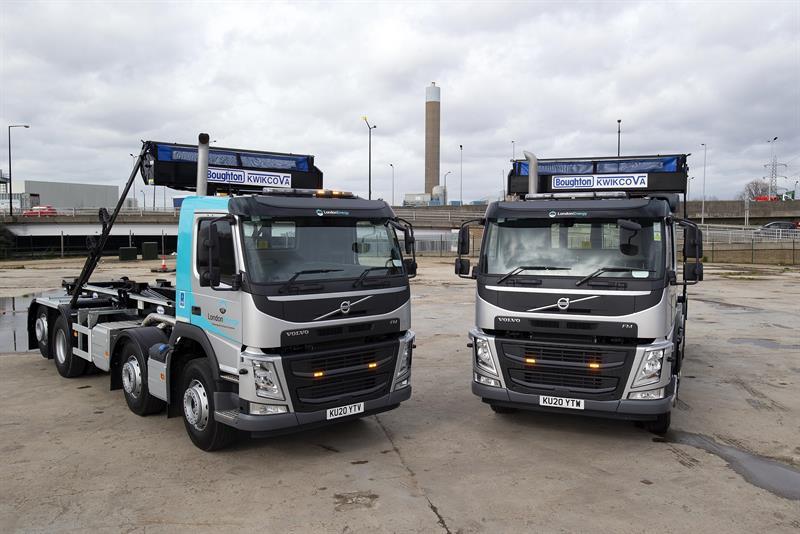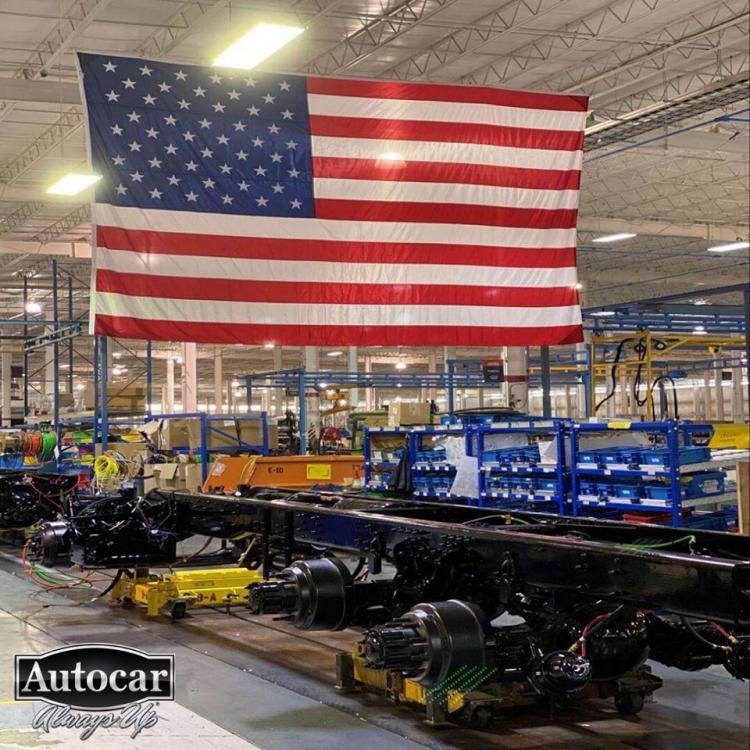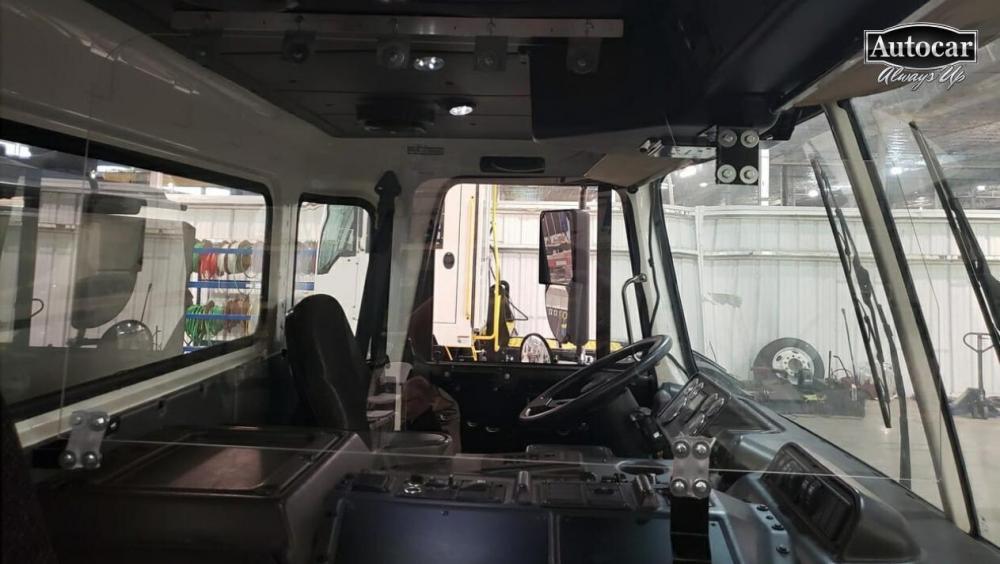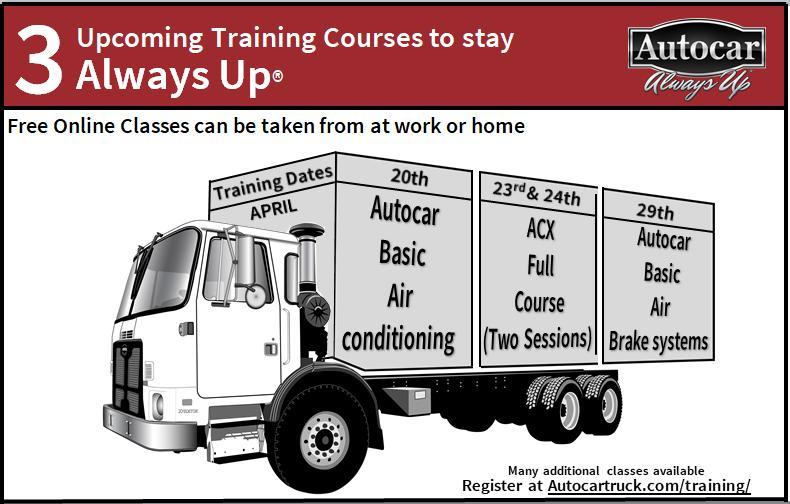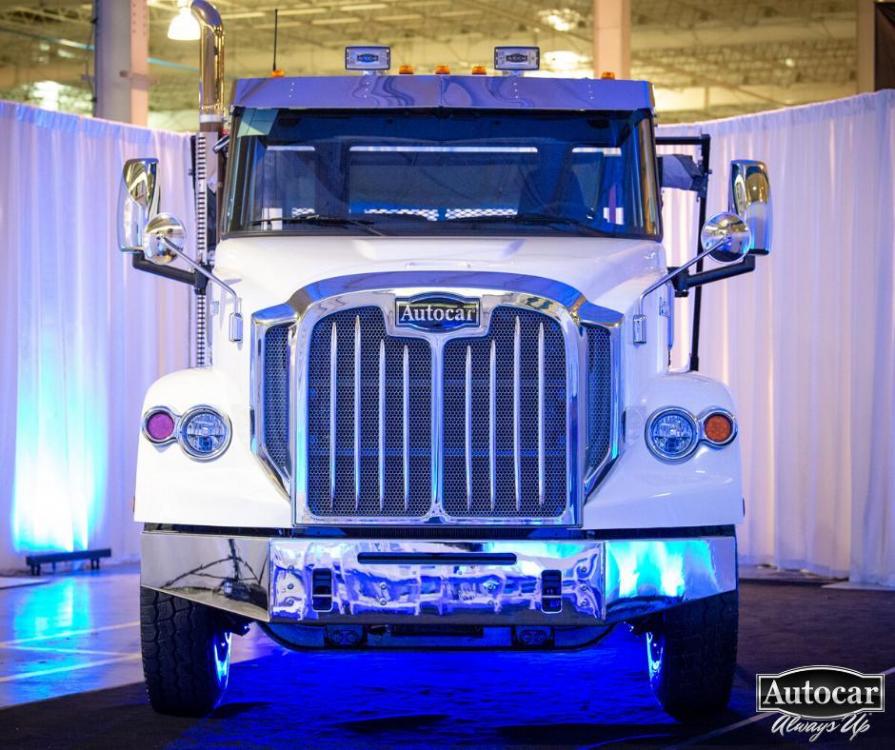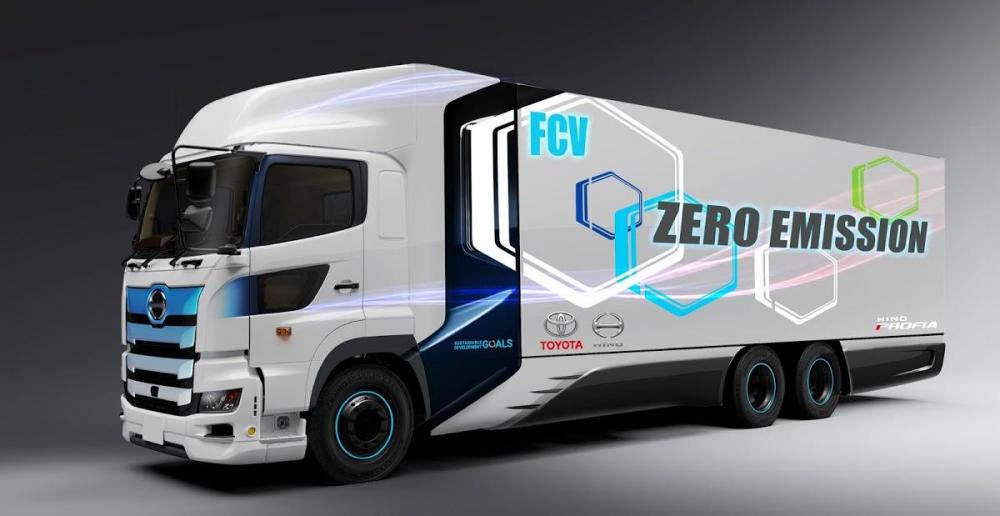
kscarbel2
Moderator-
Posts
18,539 -
Joined
-
Days Won
112
Content Type
Profiles
Forums
Gallery
Events
Blogs
BMT Wiki
Collections
Store
Everything posted by kscarbel2
-
Transport Engineer / April 15, 2020 Waste management service provider LondonEnergy is taking delivery of nine Volvo FM 8x2 rigids as part of an upgrade of its hook-loader fleet, replacing a rival marque. Supplied by Volvo Truck and Bus Centre London, the Volvo FMs are powered by D11K diesel engines rated at 424bhp and will be used to service LondonEnergy’s re-use and recycling centres, transporting waste products for processing at its EcoPark facility in Edmonton. Katie Blowes, transport and logistics manager at LondonEnergy, says: “This order marks our return to Volvo after several years running hook-loaders from another manufacturer. She said it chose the FM because it was most suitable for inner-city work. The choice was also based on build quality and aftersales support. “The new fleet marks a big step forward for us in improving safety and our environmental impact, both of which play an important part in our business strategy. We aim to achieve Earned Status Recognition with the DVLA and FORS Gold Standard to show the high quality of our operation.” The new trucks, which feature Boughton Engineering bodywork, will be on the road seven days a week, covering up to 200,000 km per annum between them. LondonEnergy has specified a four-way recordable camera system linked to a dashboard-mounted monitor, Halo Cycle Minder sensors with audible left-turn alerts, an auxiliary lower window in the passenger door to give the driver a clear view of other road users and LED strobes and beacons for maximum visibility. The FMs also feature Volvo’s radar-based adaptive cruise control with forward collision warning system, which can be activated by the driver and will maintain a safe distance from the vehicle in front by controlling the accelerator and all available brakes. In the event of heavy braking, the FMs brake lights also flash rapidly to alert road users behind, helping to avoid rear-end collisions. All vehicles come equipped with Volvo’s Dynafleet telematics system, which enables the exact location and status of each truck to be tracked 24/7, for security and efficiency. The trucks have been supplied with a Volvo Gold Contract which covers all preventive maintenance and truck repairs within the Volvo Trucks dealer network. All routine maintenance will take place at Volvo Truck and Bus Centre Enfield, situated less than four miles from the customer’s base. LondonEnergy is owned by the North London Waste Authority (NLWA) and is contracted to provide waste management services to seven north London boroughs. .
-
Never an unhappy K200 operator.
-
Owner-Driver / April 14, 2020 Volvo Group Australia (VGA) is recalling more than 1,300 Mack branded trucks up to 12 years old due to potential electrical power-loss issues. The loss of power in affected vehicles may cause them shut down without warning while in operation. "Loss of electrical power will cause the truck to shut down completely and may increase the risk of an accident," the Australian Competition and Consumer Commission notes. "This could result in serious injury to vehicle occupants and other road users." The recall affects: CSM Metro-liner model years 2009-2019; CMM Granite, CMH Trident and CLX Super-liner model years 2008-2019; and CXX Titan model years 2008-2016. Affected owners will be contacted by email and advised to contact their nearest Volvo Group Australia repairing dealer to arrange for an inspection and repair of the vehicle if required. Concerned owners can contact their nearest authorised Volvo Group Australia repairing dealer on 07 3718 3500 or email vga.warranty@volvo.com. The full list of VINs can be found here.
-
Tag the heroes that are still driving our trucks! Autocar is working at full capacity and we are proud to fly our flag to remember why we need to push forward and help the US! Always Up - Autocar Trucks .
-
Ford to pay nearly 10% on new debt to plug losses Financial Times / April 17, 2020 Ford is set to pay interest rates of almost 10 percent to access the bond market, as the US carmaker raises cash it needs to ride out a global economic shutdown due to the coronavirus pandemic. Ford launched an $8 billion fundraising on Friday, after telling investors it expects to post a $2 billion loss in the first quarter on $34 billion in revenue. With most of Ford’s plants around the world shuttered and consumers in many markets unable to get to car dealerships, the results reflect a sharp contraction. In the first quarter of 2019, the company reported net income of $1.1 billion on $40 billion in revenue. Ford, which was stripped of its investment-grade credit rating last month, had indicated early on Friday that it was willing to pay yields as high as 11 percent on the new debt. But the offering drew $20 billion of orders within the first two hours, and the strong demand meant it was able to cut the yields substantially from early indications. Ford is set pay a 9.625 percent yield on $1 billion of 10-year debt. It is also issuing $3.5 billion of five-year bonds yielding 9 percent and $3.5 billion of three-year debt yielding 8.5 percent. Ford was able to raise five-year bonds at an interest rate of just 3.5 percent in February, meaning its funding costs have more than doubled in a matter of months. The last time the carmaker had to pay such onerous rates to raise debt was in the depths of the financial crisis in 2008, when it paid 18 percent to access the market. Ford carries a junk rating from agencies Moody’s and S&P, but its bonds are still eligible for the Federal Reserve’s corporate bond buying scheme. The US central bank announced that it would buy corporate bonds that were rated investment-grade on March 22, before the carmaker lost its prized upper-tier credit rating. Ford was already struggling to realise the benefits of a global restructuring that began in 2018 before the pandemic hit, and had disappointed investors and analysts with previous quarterly earnings. Meeting consensus earnings expectations no longer matters, however, according to Morningstar equity analyst David Whiston. “At this point the only thing that matters is survival,” he wrote in a note to clients. The only Ford factories that are producing and selling cars to dealers right now are at its joint ventures in China, where the virus first took hold and the economy is now reopening. Ford sold 516,330 cars, trucks and sport utility vehicles in North America between January and March, a decrease of nearly 13 per cent from a year earlier. In China, the number of vehicles sold dropped 35 per cent to 88,770 vehicles, but sales began to recover in March. Ford plans to restart its manufacturing plants and supply network sometime in the second quarter. Ford has $30 billion in cash on its balance sheet, which chief financial officer Tim Stone said is “sufficient . . . to get us through at least the end of the third quarter with no incremental vehicle production and wholesales or financing actions”. Mr Whiston estimated that, prior to the bond issue, the company had enough cash to last about six months. Ford raised more than $15bn of cash last month by drawing down on credit facilities with banks.
-
The US shipped millions of masks to China earlier this year, despite warnings that a pandemic was about to hit Michelle Mark, Business Insider / April 18, 2020 American manufacturers were encouraged by the United States government to ship millions of masks and other medical supplies to China this year, despite warnings that those items would soon be necessary, The Washington Post reported Saturday. The US has for weeks suffered major shortages of protective items for frontline health care workers and first responders treating coronavirus patients. Meanwhile, hospitals and local US governments have reported major delays in receiving shipments of those products from China. Doctors and nurses have reported widespread rationing and reusing of masks and other protective items, exposing them to increased risk of coronavirus transmission. In January and February of 2020, US manufacturers exported $17.6 million in face masks and other vital medical supplies, according to a Post analysis of customs data.
-
Tornado damaged BorgWarner plant may disrupt Ford output Bloomberg / April 17, 2020 Ford is warning of significant damage wreaked by a tornado in South Carolina this week that knocked out a BorgWarner auto parts plant supplying a key component for the automaker’s most profitable models. The Seneca, S.C., parts factory makes transfer cases, an important component of four-wheel-drive systems that Ford uses in its F-150 pickup, its biggest moneymaker, as well profitable SUVs such as the Explorer and Lincoln Navigator, the automaker said Friday in a securities filing. “We do not have sufficient information to estimate when the facility will be back online or whether, or the extent to which, this incident will impact our plans to resume production of four-wheel drive and all-wheel drive vehicles,” Ford said. BorgWarner’s plant, one of its largest drivetrain manufacturing facilities, was struck by a tornado on April 13 and the company said it’s still assessing the extent of the damage. “Currently, the time to resume operations, partially or in full, cannot be estimated,” the parts maker said in its own filing Thursday. .
-
Ford's logistics team scrambles to launch protective gear output Michael Martinez, Automotive News / April 19, 2020 DETROIT — Ford's pivot from transmissions to face masks at a Michigan plant began with an executive's late-night text to a colleague. It quickly morphed into a complex, intercontinental scramble to secure and ship machinery and materials — which was nearly thwarted by a flock of unfortunate birds. It's the stuff of a Hollywood action thriller, even for a century-old automaker that has done logistical backflips in recent years to keep vehicle production from being disrupted by supplier fires and complex plant renovations. "We have an amazing logistics team," said Adrian Price, director of global core engineering for vehicle manufacturing. "When we have issues, that team just swings into action, and they're able to work magic." Ford's decision to mass-produce face masks at its Van Dyke Transmission Plant north of Detroit is part of a larger effort to make medical equipment for health care workers and COVID-19 patients. But in addition to helping hospitals fight the coronavirus outbreak, the endeavor aims to make enough masks to protect Ford's own factory workers to facilitate safely restarting vehicle production. The idea came from China, where employees at joint venture Changan Ford had begun making masks for workers there. Price learned of the mask production March 24, a few days after being named manufacturing lead for Ford's Project Apollo, an ad hoc scramble to build ventilators, respirators and plastic face shields in the U.S. He shot a text to colleagues in China one evening on WeChat, asking about the feasibility of face mask production in the U.S. as well. A half-hour later, he was on the phone with a number of officials, including the CEO of Ford Taiwan, as Changan Ford had obtained its mask-making machines there. By the time Price woke up the next morning, the team in China had located the necessary equipment: 10 machines, roughly 20 to 25 feet long, each capable of rolling out 100,000 masks a day. Ford had the first two available machines quickly delivered to its Lio Ho Motor Co. joint-venture plant in Taiwan. The machines were then trucked to the closest airport, and they arrived at the Michigan plant March 31, along with some initial material. Ford chose the plant, which supplies the Explorer, Escape and other vehicles, because of its Class A clean room designed for handling delicate transmission parts. The equipment was up and running by April 3 — but not for long. Face masks are made up of six different materials: an inner layer, a filter, an outer layer, a soft metal nose piece, ear straps and side hemming. As Ford was coordinating the machine deliveries, it was simultaneously searching for a supplier with material available in bulk. It found one in Shanghai. With no commercially available way to transport the fabric to the U.S., Ford planned to fly it over on a Boeing 747, one of 22 planes its logistics team had chartered from China to the U.S. in February, when the virus was beginning to spread, for future flights. But shortly after the jet took off from Shanghai, it struck a flock of birds and lost an engine, forcing the pilot to return to the airport. The next flight out wasn't for another week. "I was really worried," Price said. "My concern was that we'd be sitting here having done all this work in such a short time and not be able to run the machines because we didn't have material. Once you lose a 747, it's hard to find a replacement." But that's exactly what Frank Mosquera, Ford's behind-the-scenes logistics whiz, did. Within five hours, according to Price, Mosquera's team located a Federal Emergency Management Agency (FEMA) flight from Shanghai to Columbus, Ohio. After quick negotiations, FEMA officials agreed to make room for Ford's cargo, and the masks were en route. By the time the plane touched down in Columbus, Ford had a helicopter ready to ferry the material for the final 90-minute leg of its journey, directly to the plant. Since then, Ford Taiwan sent workers to speed production of the other eight machines at the supplier making them. They have been able to pull ahead delivery by multiple days. Ford expected to have almost all of the machines up and running by early this week. Price said Van Dyke Transmission should be able to produce millions of masks per week, each stamped with the script Ford wordmark. "One of the powers of Ford is our ability to bring together incredibly talented professionals in all these fields to work together as one Ford," Price said. "That's the embodiment of everything we do from a culture standpoint. It makes me feel tremendously proud of our team."
-
Protecting your truck operators helps protect everyone! When you purchase Autocar’s truck cab divider, profits will go to The CDC foundation to support the fight against COVID-19. Want to help fight COVID-19? Call us now to join our effort at 888-218-3611➡️2➡️1 Always Up - Autocar Trucks .
-
Reuters / April 17, 2020 U.S. airlines are estimated to be sitting on more than $10 billion in travel vouchers that should have been cash refunds from canceled flights, a group of senators released on Friday. Many U.S. airlines are cancelling between 60% and 80% of their flights, and under federal law passengers on those flights are entitled to full refunds, Senators Ed Markey, Elizabeth Warren and Richard Blumenthal said. "However, many airlines have been obfuscating this right by offering travel vouchers as the default option, requiring passengers to take burdensome steps to request refunds instead," they said. The senators had asked Alaska Airlines, Allegiant Air, American Airlines, Delta Air Lines, Frontier Airlines, Hawaiian Airlines, JetBlue Airways, Southwest Airlines, Spirit Airlines, Sun Country Airlines, and United Airlines to each provide details on their refund policies during the pandemic. In the airline replies, most refused to share the total value of the travel vouchers and credits they have issued during the pandemic. But JetBlue, which has 5.5% of the domestic market share, said it issued over $20 million per day of travel credits to consumers in the first few weeks of March. "Assuming a similar trend throughout the industry over the last month, this figure could mean that the airlines are sitting on more than $10 billion in customer cash," the lawmakers said, while inviting airlines to provide more information if they dispute the figure. According to their findings, airlines are offering cash refunds when the company itself cancels a flight, as required by the U.S. Transportation Department, but only Allegiant and Spirit are offering refunds to passengers who voluntarily cancel their own tickets. "None of the biggest carriers with the most revenue, including United, American, Delta, and Southwest, offer similar refunds," it said. U.S. airlines are set to soon receive $25 billion in government payroll aid, much of it in the form of free cash, and can also apply for another $25 billion in government loans to help them weather the coronavirus downturn. Two weeks ago, the Transportation Department issued a notice to airlines reminding them they are obligated to refund tickets when they cancel a flight or make a significant flight schedule change that passengers opt not to accept, but did not take any immediate action against airlines.
-
Ford targets May 4 for Kentucky Truck Plant restart Michael Martinez, Automotive News / April 16, 2020 DETROIT -- Ford is joining other automakers and suppliers by targeting May 4 to restart assembly lines in at least one U.S. plant, according to a union official. In a letter to members, Kentucky Truck Plant chairman Allen Hughes said Ford planned to reopen its Louisville facility on a two-shift, Monday-Thursday pattern, although he noted "this is not finalized and is very tentative." It was unclear whether Ford was targeting a May 4 restart for all U.S. plants, or if it was specific to Kentucky Truck. A Ford spokeswoman on Thursday said there were no updates to announce beyond its previous announcement that production would be delayed indefinitely. May 4 is also the date of U.S. plant reopenings at Fiat Chrysler, Honda, Hyundai, Volvo and Toyota and supplier Magna International Inc., as the industry seeks to begin recovery from the coronavirus pandemic that has halted production, closed dealer showrooms and stymied sales demand. Magna President Swamy Kotagiri expressed concern in an interview with Reuters that the industry avoid false starts. "The most important thing is, how can we as an industry coordinate and minimize the start-stops?" he said. "If someone comes and says, 'It's not May 4, it's May 10.' That's OK. It's easy to deal with. But if somebody comes and says to start on the 4th and we stop again on the 12th, that's a bigger problem." Hughes said Ford is planning safety measures for its restart. At least eight UAW members at Ford plants have died from coronavirus-related issues, the union has said. "The company's plans are wide-ranging and have been changing daily, partly due to the changes to the coronavirus guidelines" from the Centers for Disease Control and Prevention, he said. Those plans could include buzzing wristbands that would alert workers when they're within 6 feet of each other. Ford this week announced it would begin face mask production at its Van Dyke Transmission plant and would provide masks to all of its factory workers.
-
Ford warns of large surprise loss and revenue miss MarketWatch / April 17, 2020 Ford warned Friday of a large surprise loss and a revenue miss. Ford expects to report a first-quarter net loss of about $2 billion. The consensus was for net income of $278.3 million. Ford said revenue is expected to be about $34 billion, below the consensus of $35.4 billion. Ford said it plans to report first-quarter results, as well as estimates on the effect of the COVID-19 pandemic on its business, on April 28.
-
Autocar Trucks / April 16, 2020 Proud Autocar owners! Follow our training opportunities and choose your preferred date and class. Stay "always up!" .
-
MarketWatch / April 16, 2020 University of Chicago Medicine researchers said they saw “rapid recoveries” in 125 COVID-19 patients taking Gilead Sciences Inc.’s experimental drug remdesivir as part of a clinical trial. 125 people with COVID-19 receiving care at the University of Chicago are participating in two Phase 3 clinical trials conducted by Gilead; 113 of them have severe forms of the disease. When people start taking remdesivir, fevers come down and some come off ventilators. One trial is evaluating remdesivir in 2,400 people with severe forms of the disease, the other is testing the drug in 1,600 patients who are moderately ill. Both trials are being conducted at multiple sites around the world. Both trials began in March and are expected to conclude in May.
-
Brian Dennehy, a versatile character actor whose career spanned five decades, has died at the age of 81, his talent agency confirmed. Dennehy, a two-time Tony Award winner who co-starred in a wide range of films, often in tough-guy roles, died of natural causes in Connecticut on Wednesday night, ICM Partners announced in a statement. In a tweet, his daughter described him as "larger than life" and "generous to a fault." Dennehy co-starred in a long list of popular movies, including "First Blood" (as the local sheriff who clashes with Sylvester Stallone's Rambo), the western "Silverado," and the science-fiction classic "Cocoon." He played Chris Farley's dad in the comedy "Tommy Boy," and portrayed basketball coach Bobby Knight in a made-for-TV movie. A former college football player at Columbia University, Dennehy appeared in a number of TV shows before making his movie debut in the Burt Reynolds movie "Semi-Tough" as a football player. He quickly went on to roles in the movies "10," "F.I.S.T." He also had a regular part in the series "Dynasty." "Just devastated to learn that the magnificent Brian Dennehy has died," actress Mia Farrow wrote on Twitter. "They is no one I enjoyed working with more. And there are few friends as valued in my life. I took this photo backstage when we were in 'Love Letters.' He loved my pup Bowie." Dennehy won a Tony for his role in "Death of a Salesman," later playing the part in a TV production of the play. He received another for "Long Day's Journey Into Night." Dennehy had continued to work recently in such series as "Hap and Leonard" and NBC's "The Blacklist." Fellow actors mourned Dennehy on Thursday. Michael McKean called Dennehy a "brilliant and versatile" and "a powerhouse actor." Marlee Matlin said "his passing is a terrible loss." Dennehy had a slightly more humble reflection on his body of work in an interview with the Daily Actor in 2018. "I'm now 80 and I'm just another actor and that's fine with me. I've had a hell of a ride," he said. "I have a nice house. I haven't got a palace, a mansion, but a pretty nice, comfortable home. I've raised a bunch of kids and sent them all to school, and they're all doing well. All the people that are close to me are reasonably healthy and happy. Listen, that's as much as anybody can hope for in life." . .
-
Reuters / April 16, 2020 Parts of President Trump’s guidelines for re-opening the U.S. economy amid the coronavirus pandemic emerged on Thursday, revealing a three-phase plan that could allow some states to begin as early as this month lifting limits meant to contain the disease’s spread. In the first phase of Trump’s guidelines, to be publicly unveiled on Thursday evening, larger venues like restaurants and movie theaters could operate again with strict social distancing, according to a copy seen by Reuters. Non-essential travel could resume and schools could open their doors again in phase two. In phase three medically vulnerable people could resume public interactions. President Trump told governors of states that some could re-open their states by May 1 or earlier. He was also expected to soon announce hiring plans for tracking the disease’s spread -------------------------------------------------------------------------------------------- Ending the US coronavirus lockdown too early could lead to an explosion of new coronavirus cases, according to an MIT study modelling the spread of the virus. Researchers from the Massachusetts Institute of Technology (MIT) created a model showing the spread of the deadly virus using publicly available data from Wuhan, Italy, South Korea and the USA. The authors say that any immediate or near-term relaxation of quarantine measures already in place in the US would lead to an 'exponential explosion' in COVID-19 cases. The model developed by the MIT team is the first to be based purely on COVID-19 data - all previous models used SARS and MERS information to chart the outbreak. It uses a neural network to draw a direct correlation between quarantine measures and a reduction in the effective reproduction number of the virus. Most models predict the spread of disease by looking at people susceptible, exposed, infected and recovered but this model captures the number of infected individuals still in quarantine and unable to infect others. This allows them to go beyond existing models and create a much more accurate system to predict the future impact of the virus if lockdowns are ended early. 'Our model is the first which uses data from the coronavirus itself and integrates two fields: machine learning and standard epidemiology,' explains Raj Dandekar, a PhD candidate studying civil and environmental engineering. 'The neural network is learning what we are calling the "quarantine control strength function".' It reveals that that in places like South Korea, where there was immediate government intervention in implementing strong quarantine measures, the virus spread plateaued more quickly. In contrast, places like the US and Italy where government interventions were slower the 'effective reproduction number' of COVID-19 was higher than one, meaning the virus has continued to spread exponentially. 'Our model shows that quarantine restrictions are successful in getting the effective reproduction number from larger than one to smaller than one,' says Professor George Barbastathis. 'That corresponds to the point where we can flatten the curve and start seeing fewer infections.' They predict COVID-19 infections will reach a plateau in the US and Italy next week but say this isn't a reason to relax lockdown measures already in place. The study authors say: 'Relaxing or reversing quarantine measures right now will lead to an exponential explosion in the infected case count.' New York Governor Andrew Cuomo has extended New York's coronavirus lockdown by two weeks until May 15. Cuomo said on Thursday that while the rate of hospitalisations in New York is decreasing, it was still unclear how many people have actually been infected with COVID-19. He said the unknown tally of infections is what is stopping him from reopening the economy because if people who don't know they are infected return to work, they risk infecting countless others and wiping out all the progress that has been made. According to Barbastathis, Singapore is a prime case study for the dangers that could stem from relaxing quarantine measures too quickly. While the team didn’t study Singapore’s COVID-19 cases in their research, 'the second wave of infection this country is currently experiencing reflects their model’s finding about the correlation between quarantine measures and infection rate.' 'If the US were to follow the same policy of relaxing quarantine measures too soon, we have predicted that the consequences would be far more catastrophic,' Barbastathis adds.
-
General Patton's Dodge WC57 Command Car headed to auction
kscarbel2 replied to kscarbel2's topic in Odds and Ends
Is it for sale, Andy ? -
Autocar Trucks Press Release / April 15, 2020 We are proud to announce the delivery of the first production model DC-64R conventional roll-off to WCA Waste Corporation of Houston, TX. In May, 2019, Autocar partnered with WCA Waste Corporation to produce our first collaborative effort; a result of careful planning and production. “The three C’s of a healthy relationship are communication, compromise and commitment. WCA Waste was the right partner, and we learned to communicate, to compromise, and to stay committed so that trust was established and extraordinary results were created. This has been a long time coming.” - Jimmy Johnston, Autocar President. .
-
Navistar implements across-the-board cuts to conserve cash
kscarbel2 replied to kscarbel2's topic in Trucking News
Navistar is talking a new plant near San Antonio at Mitchell Lake. The previous Navistar plant in Texas, the former Marmon truck plant, was in Garland (a northeast Dallas suburb). (Peterbilt's Denton plant is located northwest of Dallas.) https://www.google.com/maps/place/Mitchell+Lake/@29.3336456,-98.5218553,11z/data=!4m5!3m4!1s0x865c562c3dc72d35:0xc9ae54fb9bc22e6d!8m2!3d29.2797557!4d-98.4911065?hl=en https://www.google.com/maps/place/Garland,+TX/@32.8273713,-96.9442296,10z/data=!4m5!3m4!1s0x864c03c1db5fc275:0x71fbdcb38623cd0!8m2!3d32.912624!4d-96.6388833 https://www.google.com/maps/place/Denton,+TX/@33.304107,-97.156147,9z/data=!4m5!3m4!1s0x864c4ca0c088b1d1:0x724474cb4814fb1b!8m2!3d33.2148412!4d-97.1330683?hl=en The new CAT excavator plant is in Victoria, Texas, between Houston and San Antonio towards the coast. https://www.caterpillar.com/en/careers/career-areas/victoria.html I'm unsure if the Denton plant is still active..............http://www.buzzfile.com/business/Caterpillar-309-578-8639 CAT closed the Waco plant in 2018....................https://www.wsj.com/articles/caterpillar-to-close-texas-plant-review-illinois-factory-1521225422 -
Reuters / March 23, 2020 Toyota on Monday said it would develop a fuel-cell powered heavy truck with its Hino subsidiary as it sees hydrogen technology as a zero-emissions alternative to battery power for large commercial vehicles. Toyota said the truck, based on Hino’s 700 Series, would be equipped with two fuel cell stacks developed for the next model of its Mirai fuel cell sedan. The truck will have a range of 600 kilometers (373 miles). Toyota has long touted fuel cell vehicles as the ultimate “green car”, and sees the technology as more efficient than battery electric cars, embraced by many rivals as a zero-emissions alternative to gasoline vehicles. .
-
Navistar implements across-the-board cuts to conserve cash
kscarbel2 replied to kscarbel2's topic in Trucking News
I do not yet know Bob. It appears to be a compromise plant, in the US but adjacent to Mexico, assembling truck in country with a large portion of imported parts.
BigMackTrucks.com
BigMackTrucks.com is a support forum for antique, classic and modern Mack Trucks! The forum is owned and maintained by Watt's Truck Center, Inc. an independent, full service Mack dealer. The forums are not affiliated with Mack Trucks, Inc.
Our Vendors and Advertisers
Thank you for your support!


